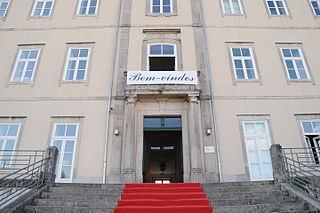
Afonso de Albuquerque, 1st Duke of Goa ([ɐˈfõsu ði aɫβuˈkɛɾk ]; was a Portuguese general, admiral, and statesman. He served as viceroy of Portuguese India from 1509 to 1515, during which he expanded Portuguese influence across the Indian Ocean and built a reputation as a fierce and skilled military commander.

The State of India, also referred as the Portuguese State of India or simply Portuguese India, was a state of the Portuguese Empire founded six years after the discovery of a sea route to the Indian subcontinent by Vasco da Gama, a subject of the Kingdom of Portugal. The capital of Portuguese India served as the governing centre of a string of military forts and trade posts scattered all over the Indian Ocean.
The lyceum is a category of educational institution defined within the education system of many countries, mainly in Europe. The definition varies among countries; usually it is a type of secondary school.

The postal history of Portuguese India goes back to the earlier days of the colony. The postal history begins with communication between the Viceroy and the Court at Lisbon soon after the conquest of Old Goa by Afonso de Albuquerque in 1510. Letters, written in triplicate, were carried by separate ships because of the hazards of the voyage. Mail was carried by an overland route, as well. The early communications of Portuguese India had an official character and the correspondence is now to be found in museums and governmental and ecclesiastical archives.
Goa Vidyaprasarak Mandal, founded in 1911, is one of the prominent educational institutions in Goa, a small state on the west coast of India. It operates two senior colleges, including a college of education, one higher secondary school, five high schools and one kindergarten and primary school.

Porvorim, is the De facto legislative and executive capital of the state of Goa, India, as both the Goa Legislative Assembly and Secretariat are functioning from the same complex in the region of Alto Porvorim in porvorim.(Alto - Portuguese word meaning high or upper). Soon it will also become the De facto judicial capital of Goa, when the High Court of Bombay at Goa which is currently functioning from Lyceum complex in Panaji, is transferred to the new building complex which is being constructed in Alto - Betim Porvorim region of Porvorim. The construction of the new building is expected to be completed by December 2020. Porvorim is situated on the right bank of the Mandovi River, as de jure capital of Goa, Panaji is located on the opposite bank. Porvorim is considered an upmarket residential hub as it lies on the Mumbai–Goa highway NH66. Goa's largest shopping centre - Mall De Goa - is situated here.

This is a historical timeline of Portugal.

NRP Afonso de Albuquerque was a warship of the Portuguese Navy, named after the 16th-century Portuguese navigator Afonso de Albuquerque. She was destroyed in combat on 18 December 1961, defending Goa against the Indian Armed Forces Annexation of Goa.

The Sá de Miranda Secondary School, is a Portuguese Public school in civil parish of São Vicente, in the municipality of Braga, in the northern district of Braga.

The Portuguese conquest of Goa occurred when the governor Afonso de Albuquerque captured the city in 1510 from the Adil Shahis. Goa, which became the capital of the Portuguese East Indies and Portuguese Indian territories such as Bom Baim, was not among the places Albuquerque was supposed to conquer. He did so after he was offered the support and guidance of Timoji and his troops. Albuquerque had been given orders by Manuel I of Portugal to capture Hormuz, Aden and Malacca only.

The title Duke of Goa was the first Portuguese ducal title given outside the royal family, and the first Portuguese noble title to be granted to a territory overseas, Goa, India.
Events from the year 1510 in India.
The Secondary School Eça de Queirós is a secondary school located in the civil parish of Póvoa de Varzim, Beiriz e Argivai, in the Portuguese Norte region, founded on 14 June 1904.

Churches and Convents of Goa is the name given by UNESCO to a set of religious monuments located in Goa Velha, in the state of Goa, India, which were declared a World Heritage Site in 1986.

Liceu Domingos Ramos is a public secondary school in the northern part of the city centre (Plateau) of Praia, Cape Verde. As of 2015, it has 2,300 students, 63 classes and 110 teachers. It was established as Liceu Adriano Moreira in 1960. In 1975, at the independence of Cape Verde, it was renamed Liceu Domingos Ramos.
Liceu Ludgero Lima is a secondary school in Mindelo, Cape Verde. The school is named after Ludgero Lima, a former employee and fighter for Cape Verdean independence, who died in an aviation accident in March 1975. Since 1968 it is housed in a building on Rua Jonas Wanon, in the neighbourhood Chã de Cemitério, southeast of the city centre, designed by the Portuguese architect Eurico Pinto Lopes.
The National Lyceum Kwame N'Krumah is a Bissau-Guinean educational institution, based in Bissau, the country's capital.
The 28 de Novembro Public Secondary School is a Timorese educational institution based in Becora, in Dili, the country's capital. It is one of the largest educational institutions in East Timor.

Bruno Dias Souza is a Goan-born architect credited with having "belonged to a generation of architects that sought to rediscover what Modern architecture meant for India" and having had an "illustrious architectural career".











